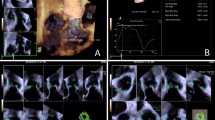Abstract
To assess the impact of aortic root asymmetry on the relationship between aortic dimensions derived from two-dimensional transthoracic echocardiography (TTE) as compared with cross-sectional cardiovascular magnetic resonance (CMR) imaging in adults with a bicuspid aortic valve (BAV). Maximal CMR cross-sectional aortic measurements at the level of the sinuses of Valsalva, including cusp–commissure, cusp–cusp diameters and aortic root areas, from 68 consecutive patients (65 % male) were retrospectively analyzed. The degree of aortic root asymmetry on CMR was expressed using the coefficient of variance of the root diameters in each dimension for an individual (CoeffVi) as compared with the median of the entire population (CoeffVp) and asymmetry was defined as CoeffVi > CoeffVp. Values obtained from CMR were compared with standard root measurements using TTE from contemporary studies (48 patients, 71 %). Reproducibility of CMR measurements was assessed using the intra-class correlation coefficient (ICC). Echocardiography systematically underestimated aortic root dimensions in comparison with CMR, particularly in asymmetric roots with cusp–cusp measurements in systole (bias: −4.9 mm). Best agreement between modalities existed in symmetric roots with cusp–commissure measurements in diastole (bias: −0.01 mm). CMR measurements showed excellent intra-reader (ICC ≥ 0.98) and moderate inter-reader (ICC range 0.37–0.95) reproducibility, particularly aortic root area (inter/intra-reader ICC ≥ 0.94). In comparison to cross-sectional CMR diameters, standard TTE measurements consistently underestimates maximum aortic root diameter in adults with a BAV and aortic root asymmetry further decreases the agreement between CMR and TTE. CMR-derived aortic root measurements are reproducible and aortic root area showed the best reproducibility.




Similar content being viewed by others
References
Siu SC, Silversides CK (2010) Bicuspid aortic valve disease. J Am Coll Cardiol 55:2789–2800
Tzemos N, Therrien J, Yip J, Thanassoulis G, Tremblay S, Jamorski MT, Webb GD, Siu SC (2008) Outcomes in adults with bicuspid aortic valves. JAMA 300:1317–1325
Zanotti G, Vricella L, Cameron D (2008) Thoracic aortic aneurysm syndrome in children. Semin Thorac Cardiovasc Surg Pediatr Card Surg Annu 11:11–21
Davies RR, Goldstein LJ, Coady MA, Tittle SL, Rizzo JA, Kopf GS, Elefteriades JA (2002) Yearly rupture or dissection rates for thoracic aortic aneurysms: simple prediction based on size. Ann Thorac Surg 73:17–27
David TE (2010) Surgical treatment of ascending aorta and aortic root aneurysms. Prog Cardiovasc Dis 52:438–444
Bonow RO, Carabello BA, Kanu C et al (2006) ACC/AHA 2006 guidelines for the management of patients with valvular heart disease: a report of the American College of Cardiology/American Heart Association Task Force on Practice Guidelines (writing committee to revise the 1998 Guidelines for the Management of Patients With Valvular Heart Disease): developed in collaboration with the Society of Cardiovascular Anesthesiologists: endorsed by the Society for Cardiovascular Angiography and Interventions and the Society of Thoracic Surgeons. Circulation 114:e84–e231
Hiratzka LF, Bakris GL, Beckman JA et al (2010) 2010 ACCF/AHA/AATS/ACR/ASA/SCA/SCAI/SIR/STS/SVM Guidelines for the diagnosis and management of patients with thoracic aortic disease. A Report of the American College of Cardiology Foundation/American Heart Association Task Force on Practice Guidelines, American Association for Thoracic Surgery, American College of Radiology,American Stroke Association, Society of Cardiovascular Anesthesiologists, Society for Cardiovascular Angiography and Interventions, Society of Interventional Radiology, Society of Thoracic Surgeons,and Society for Vascular Medicine. J Am Coll Cardiol 55:e27–e129
Lang RM, Bierig M, Devereux RB et al (2005) Recommendations for chamber quantification: a report from the American Society of Echocardiography’s Guidelines and Standards Committee and the Chamber Quantification Writing Group, developed in conjunction with the European Association of Echocardiography, a branch of the European Society of Cardiology. J Am Soc Echocardiogr 18:1440–1463
Braverman AC, Guven H, Beardslee MA, Makan M, Kates AM, Moon MR (2005) The bicuspid aortic valve. Curr Probl Cardiol 30:470–522
Vahanian A, Alfieri O, Andreotti F et al (2012) Guidelines on the management of valvular heart disease (version 2012): the Joint Task Force on the Management of Valvular Heart Disease of the European Society of Cardiology (ESC) and the European Association for Cardio-Thoracic Surgery (EACTS). Eur Heart J 33:2451–2496
Kilner PJ, Geva T, Kaemmerer H, Trindade PT, Schwitter J, Webb GD (2010) Recommendations for cardiovascular magnetic resonance in adults with congenital heart disease from the respective working groups of the European Society of Cardiology. Eur Heart J 31:794–805
Groth M, Henes FO, Mullerleile K, Bannas P, Adam G, Regier M (2012) Accuracy of thoracic aortic measurements assessed by contrast enhanced and unenhanced magnetic resonance imaging. Eur J Radiol 81:762–766
Freeman LA, Young PM, Foley TA, Williamson EE, Bruce CJ, Greason KL (2013) CT and MRI assessment of the aortic root and ascending aorta. AJR Am J Roentgenol 200:W581–W592
Sievers HH, Schmidtke C (2007) A classification system for the bicuspid aortic valve from 304 surgical specimens. J Thorac Cardiovasc Surg 133:1226–1233
Burman ED, Keegan J, Kilner PJ (2008) Aortic root measurement by cardiovascular magnetic resonance: specification of planes and lines of measurement and corresponding normal values. Circ Cardiovasc Imaging 1:104–113
Cawley PJ, Maki JH, Otto CM (2009) Cardiovascular magnetic resonance imaging for valvular heart disease: technique and validation. Circulation 119:468–478
Pennell DJ, Sechtem UP, Higgins CB et al (2004) Clinical indications for cardiovascular magnetic resonance (CMR): consensus Panel report. Eur Heart J 25:1940–1965
Joziasse IC, Vink A, Cramer MJ, van Oosterhout MF, van Herwerden LA, Heijmen R, Sieswerda GTJ, Mulder BJM, Doevendans PA (2011) Bicuspid stenotic aortic valves: clinical characteristics and morphological assessment using MRI and echocardiography. Neth Heart J 19:119–125
van der Linde D, Rossi A, Yap SC et al (2013) Ascending aortic diameters in congenital aortic stenosis: cardiac magnetic resonance versus transthoracic echocardiography. Echocardiography 30:497–504
Tsai SF, Trivedi M, Daniels CJ (2012) Comparing imaging modalities for screening aortic complications in patients with bicuspid aortic valve. Congenit Heart Dis 7:372–377
Conflict of interest
None.
Author information
Authors and Affiliations
Corresponding author
Rights and permissions
About this article
Cite this article
Torres, F.S., Windram, J.D., Bradley, T.J. et al. Impact of asymmetry on measurements of the aortic root using cardiovascular magnetic resonance imaging in patients with a bicuspid aortic valve. Int J Cardiovasc Imaging 29, 1769–1777 (2013). https://doi.org/10.1007/s10554-013-0268-9
Received:
Accepted:
Published:
Issue Date:
DOI: https://doi.org/10.1007/s10554-013-0268-9




